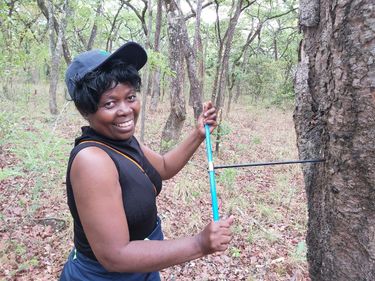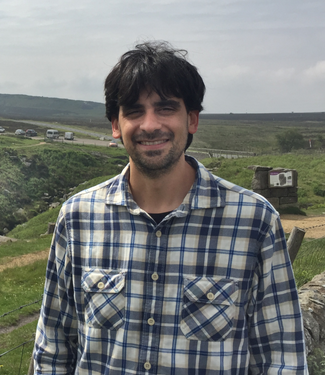
Sessions in which Yu-Mei Jiang participates
Tuesday 28 June, 2022
Tree radial growth is influenced by various climatic and non-climatic factors, which can complicate the extraction of climate signals in tree rings. We investigated the disturbance impact on tree ring width (RW) and latewood blue intensity (BI) chronologies of Norway spruce in Carpathian Mountains. Aiming to explore the extent to which disturbance can affect the expression of temperature signals in tree rings. Nearly 15000 tree cores from 34 sites were collected and analyzed. Disturbance t...
Sessions in which Yu-Mei Jiang attends
Monday 27 June, 2022
MAIDENiso is a numerical process-based model that allows researchers to simulate the growth of a virtual tree. Using daily meteorological data, the model simulates the physical and physiological processes taking place in the tree and its environment, to produce daily and yearly outputs comparable to dendrological observations. The model has been adapted and used successfully in boreal regions in North America. In an inverse mode, tree-ring obs...
Free, in person and onlineWe will hold a practical, skills-based workshop introducing openDendro -- an open-source framework of the base analytic software tools used in dendrochronology in both the R and Python programming languages. openDendro is a new unified set of tree-ring analysis tools in open-source environments that provides the necessary baseline for dendro...
Tuesday 28 June, 2022
Africa is faced with a number of challenges including climate change and ecological disturbance due to various anthropogenic activities. These problems adversely affect the forests and also ecosystem services. My appreciation for the forests motivated me to pursure my undergraduate studies in Forestry. I first applied dendrochronology during my PhD research which focused on understanding the climate change vulnerability of the Zambezi teak forests in Zambia. However, lack of research facil...
Although numerous proxy-based climate reconstructions have been developed and despite the prevalence of relatively long instrumental records throughout Europe, reliable information about past climate is still lacking in some regions, particularly eastern parts of the continent. This issue is linked to limitations in data quality and large uncertainties in existing records. The REPLICATE project aims to fill this spatial paleoclimatic and data quality gap by applying a tree-ring multi-param...
Tree radial growth is influenced by various climatic and non-climatic factors, which can complicate the extraction of climate signals in tree rings. We investigated the disturbance impact on tree ring width (RW) and latewood blue intensity (BI) chronologies of Norway spruce in Carpathian Mountains. Aiming to explore the extent to which disturbance can affect the expression of temperature signals in tree rings. Nearly 15000 tree cores from 34 sites were collected and analyzed. Disturbance t...
Growing concerns about vulnerabilities of boreal forests to climate change and disturbances warrants additional information about their impacts on the growth of dominant tree species in different surrounding environments. To address these concerns, we investigated how the surrounding environment influences the growth of such trees and their responses to climate and insect epidemics in stands of eastern Canada’s boreal forest. For this, we focused on 96 black spruce, jack pine, and tremblin...
The spatial scale of climate fluctuations, or effective spatial degrees of freedom (ESDOF), depends on the timescale and the forcing: while local scale variability between far away locations may be independent on short timescales, they may become coherent over sufficiently long timescales, or if they are driven by a common forcing. While ESDOF have been estimated from instrumental data over the historical period and climate model simulations, it remains difficult to perform such analysis o...
"Emerging in the early 20th century, the scientific study of tree-rings has a rich but under-cultivated history. This project reviews the historiography (or the history of historical writing) of dendrochronology. From the pioneering work of A.E. Douglass and others to the establishment of institutions dedicated to advancing dendrochronology by the 1950s, the field has secured its place as an ensemble of techniques to interpret tree rings, with applications in archeology, climatology, ecolo...
The past and future of forests are unequivocally controlled and determined by global climate. Constraining the uncertainties within this multifaceted relationship has been the focus of vast research efforts. A spatial perspective, however, is often neglected. Using the geographical constraints (e.g. latitude, altitude) and climatic drivers of tree dynamics as a benchmark, we address the spatial patterns and changes of forest growth at a continental scale and quantify the forest growth resp...
Ultra high resolution imaging is becoming standard across the sciences and must be a priority for dendrochronology. Large format scanners fail to resolve micro rings and the anatomical structures of increasing scientific interest. Meanwhile, current software limitations include cost, user experience, data management flexibility, and capacity for handling large file sizes. We argue for a new paradigm and present a technology framework that integrates gigapixel macro photography, a cloud-hos...
Tree-ring research has given generations of scientists a long memory of what is acceptable for a tree to be included for data analysis. The established criteria, however, were set through purposeful goals to maximize the response for climatic reconstructions. Ecology is different. Tree-rings are increasingly being used to study a wide swath of ecology, including the carbon cycle or the response of ecosystems to global changes. A fundamental aspect of ecology is to understand the range of r...
Dendroclimatic reconstructions play a key role in contextualizing recent climate change by improving our understanding of past climate variability. The climatically-sensitive blue intensity (BI) parameter is gaining prominence as a more accessible alternative to X-ray densitometry. Yet accurately representing low-frequency trends and high-frequency extremes using scanner-based BI remains a challenge due to color biases and resolution limitations. As part of the REPLICATE project, methodolo...
In this work we show the application of dendrochronology as an educational resource for schoolchildren and as a mean to disseminate science to society. Tree rings are popularly known in Chile due to the massive use of wood for construction, handicrafts and firewood. The visible tree rings generate a distinct, tangible and familiar curiosity in many people. “Tree-Rings as a Natural Encyclopedia of Environmental Archives” is an exhibition built as an educational project for schoolchildren, w...
Historical accounts in the Brazilian Digital Library provide independent support for most of the tree-ring reconstructed wet season rainfall extremes in the eastern Amazon during the late-18th and 19th centuries. Newspapers, government reports, and other documents describe crop failure, livestock mortality, water shortages, and ship groundings on the Amazon River during many of the tree-ring reconstructed drought extremes. Heavy rains and flooding are described during some of the wet extre...
Tree rings have long been used to monitor forest change by measuring differences in tree ring widths through time derived from a representative sample of forest trees. However, for many reasons, tree rings have only rarely been utilized to monitor urban forest change. Urban forest change monitoring has more commonly occurred with time-series of remote sensing imagery, such as yearly stacks of Landsat satellite imagery converted to some vegetation index or other proxy. Tree rings and remote...
In the context of climate and environmental change, the boreal forest is subject to potential changes in structure and function. Stand-level physiological models can be used to predict these responses over time and to understand the interaction between tree ecophysiological processes and climate variability. We present here a project that aims to develop potential growth scenarios for Canadian boreal forest stands based on the characterization of their ecosystem fluxes using the MAIDEN mod...
Ring-width (RW) and Blue Intensity (BI) parameters (earlywood - EWB, inverted latewood – LWBinv, and delta - DB) were measured from samples of Araucaria araucana from six sites in northern Patagonia, Argentina. The distance between the most southerly and northerly sites is ca. 130 kms. Despite a much weaker between-tree signal for the BI parameters than RW, principal component analysis identifies a much stronger regional between-site signal for the BI parameters. Split period correlation r...
"Little is known about the impact of volcanoes on trees from the Southern Hemisphere. In this study, we investigated whether volcanic signals could be identified in ring widths from eight dendrochronological species from New Zealand, using superposed epoch analysis. We found that most species are good recorders of volcanic dimming and that the magnitude and persistence of the post-event response can be broadly linked to plant life history traits - whether the species responds as a 'stress ...
Insect and pathogen outbreaks, fires, hurricanes, severe drought and other disturbances alter the structure, composition and function of forests. Results from silvicultural experiments suggest disturbances in lower density forests lead to better mitigation of drought stress for surviving trees than those in higher density stands. As drought and insect and pathogen outbreaks are expected to become more severe and frequent, understanding how surviving trees’ climatic response is affected by ...
Wednesday 29 June, 2022
Dendrochronology is considered one the most precise of all the scientific dating techniques. However, it requires long sequences of tree rings and a master record for both the species and region in question. At the University of Groningen, we have been pioneering a new approach to dating that combines the precision of dendrochronology with the versatility of radiocarbon dating. It relies on the detection of spikes in the annual radiocarbon record, thought to b...
Information garnered from historical timbers and wooden artifacts (e.g. houses, barns, ships) can greatly enhance our understanding of human, ecological, and climate history, especially in regions where few old-growth forests and trees remain, tree longevity is relatively short (less than 300-400 years), and environmental conditions break down wood rather quickly, like in mesic to wet regions. Over the last decade plus, the application of tree-ring techniques on wo...
Current and projected changes in climate are estimated to be from 10 to 100 times faster than the natural adaptive capacity of trees whose generation times are long. As extreme climatic events are becoming more frequent and exert a strong selection pressure on tree populations, there is an urgent need to better characterize the genetic variability involved in the response of trees to climate. There is currently a lack of knowledge on the role of genetic variability in tolerance to climatic...
Information garnered from historical timbers and wooden artifacts (e.g. houses, barns, ships) can greatly enhance our understanding of human, ecological, and climate history, especially in regions where few old-growth forests and trees remain, tree longevity is relatively short (less than 300-400 years), and environmental conditions break down wood rather quickly, like in mesic to wet regions Over the last decade plus, the application of tree-ring techniques on woo...
Dendrochronology in eastern New York State, USA, was established from timbers used in European settlement and development of the Hudson and Mohawk River Valleys starting in the mid-17th century. The abundant primary forests were the source, and timbers were used locally and exported via the rivers. West of the Hudson River Valley, successful settlement was more precarious from human conflict until the late 18th - early 19th century, and the oldest dated buildings are located al...
Dendroclimatological reconstructions are often extended into the past with wood from historical buildings. However, the varying, though frequently unknown origin of timbers not only affects the growth rate but also the climate response of individual tree-ring samples. We tested nine supervised machine learning algorithms for the geographical provenancing of 99 historical tree-ring samples. We sampled 143 living larch (Larix decidua Mill) trees at seven sites along an elevational gradient f...
"Drought legacy effects (DLE) in radial tree growth (RTG) have been extensively studied over the last decade and are found to critically influence carbon sequestration in woody biomass. However, the statistical significance of DLE depends on our definition of expected vs. unexpected growth variability, a definition that has not received sufficient scrutiny.Here, we revisit popular DLE analyses using the ITRDB and employ a synthetic data simulation to disentangle four key factors influe...
Fire-dependent red pine (Pinus resinosa Ait.) vegetation communities in the central Appalac...
Presentation of all Ameridendro2022 posters.FREE LUNCH FOR ALL ATTENDEES!
Session reescheduled from June 28th to June 29th
Rescheduled from June 28th to June 29th
Insect and pathogen outbreaks, fires, hurricanes, severe drought and other disturbances alter the structure, composition and function of forests. Results from silvicultural experiments suggest disturbances in lower density forests lead to better mitigation of drought stress for surviving trees than those in higher density stands. As drought and insect and pathogen outbreaks are expected to become more severe and frequent, understanding how surviving trees’ climatic response is affected by ...
Thursday 30 June, 2022
How old are tropical trees? This fundamental question has long driven the curiosity of laymen and scientists. But only recently, a great number of studies conducted by many brave dendrochronologists resulted in a significant tree-ring-based knowledge that allows us to start accurately estimating tree ages across the globe. As science goes, not only knowing the longevity of tropical trees is essential to understanding forest dynamics and its role in biogeochemical cycles, but one must also ...
The assessment of pre-instrumental climate variability during the Common Era (CE) has been a key element of IPCC reports and was recently emphasized by showing a single temperature reconstruction as the first figure in the 2021 Summary for Policymakers (SPM). This reconstruction is derived from dozens of proxy records including tree-rings, corals, ice cores and sediments, and displays the course of global temperatures over the past 2000 years. Show casing a single study for paleoclimate co...
Dendrochronological archives in the tropics of the Americas have been under-studied for a long time. Some of the challenges include the Identification of tree-ring boundaries in certain tree species, absence of winter dormancy associated to low temperatures in most of the cases, and logistic difficulties of fieldwork in remote sites. However, part of the slow progress is also related to the fact that historically much less resources have been inv...
"Maximum latewood density (MXD) is the most sensitive proxy for reconstructing temperature variations over past centuries to millennia. However, the development of long MXD chronologies has lagged far behind that of ring width chronologies, especially in North America. Among a handful of millennial MXD records across the northern hemisphere, only a few are from North American sites.In this study, we fill this data gap by developing a millennial MXD data network from an unprecedented...
Tropical regions are generally characterized by dynamic ecosystems where the abundant availability of energy and resources allows for an almost constant growth of its flora, being xeric forests and flood plains some exceptions. Classical dendrochronology studies have been scarce in these areas as many tree species does not show well defined tree-ring boundaries. We present different study cases on how quantitative wood analysis and radiocarbon can complement classical dendrochronology incr...
Tree-ring widths represent the most commonly used proxy to reconstruct the climate of the last millennium at high resolution, thanks to their large-scale availability. The approach often relies on a relationship between tree-ring width series and climate estimated on the basis of a linear regression. The underlying linearity and stationarity assumptions may be inadequate. Dendroclimatic process-based models, such as MAIDEN, may be able to overcome some of the limitations of the statistical...
Dendrochronological archives in the tropics of the Americas have been under-studied for a long time. Some of the challenges include the Identification of tree-ring boundaries in certain tree species, absence of winter dormancy associated to low temperatures in most of the cases, and logistic difficulties of fieldwork in remote sites. However, part of the slow progress is also related to the fact that historically much less resources have been inv...
In this presentation we discuss the current status of tree-ring research in the neotropical Americas outside of México. The most relevant findings are discussed, including the region-wide wet season precipitation signal associated with large-scale tropical atmospheric dynamics. Our analysis suggests that local climate response patterns vary between sites, with the strongest correlations ranging from the previous summer to the current spring. Correlations with accumulation of daily precipit...
A gap of millennial tree-ring data suitable for dendroclimatology has long been evident in the North American boreal forest. In my talk, I will describe the adaptive approach we have developed to build and improve a data network for millennial dendroclimatology in the eastern Canadian taiga. Recurrence of stand replacing wildfires is the most important constrain to the elaboration of long tree ring chronologies, which can only be developed away from regions ...
Climate change across the western US has increased air temperature, resulting in decreased snow and lengthening of the summer drought. Recent studies have also highlighted the positive feedback loops between soil moisture and vapor pressure deficit (VPD), which can exacerbates aridity in water limited ecosystems. These interactions can make it difficult to untangle the influences of soil moisture and VPD on tree growth, and yet our ability to untangle these parameters is important for buil...
The interpretation of stable isotopes in a dendroecological framework can provide powerful insights into how trees adjust physiologically in response to the environment. This symposium aims to bring together researchers who use stable isotopes in tree rings to address ecophysiological responses to environmental changes from intra-annual to multi-decadal resolution. We hope this symposium will enable fruitful discussions and new ideas a...
Allies have emerged as key enablers of diversity and inclusivity initiatives in the workplace, in professional associations, and in everyday life. But what is an ally? What skills are required to be an effective ally? How do we hold ourselves and our community members accountable for being effective allies? This symposium will provide a deeper understanding of what it means to be an ally and the skills to help advance allyship as individuals and as a community. Fur...



